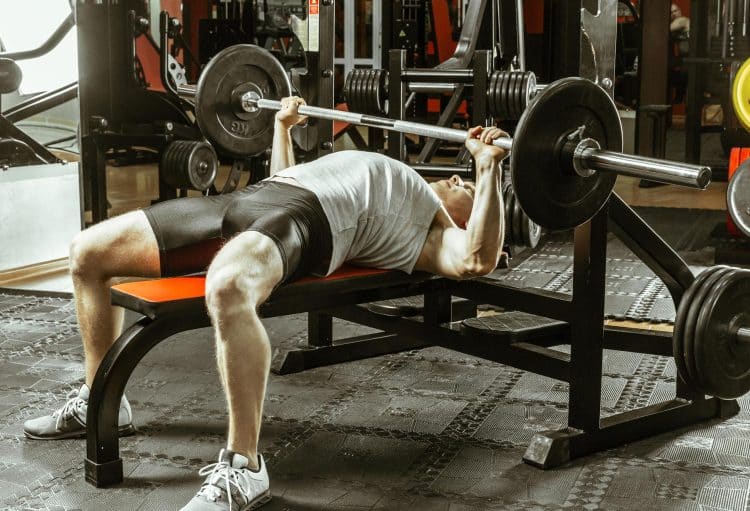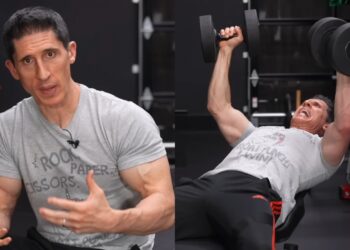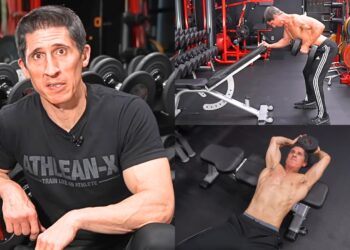Every athlete, irrespective of the sport, must work on their explosive strength to improve their overall performance. Whether you are a footballer, sprinter, or even bodybuilder, raw strength can be the key to unlocking your full potential.
Strength isn’t just about how much you can lift but also how fast you can lift it. While most lifters focus on the concentric (lifting) phase to build strength, the eccentric (lowering) motion is just as important. Scientific evidence shows that the eccentric phase might be more effective for building muscle and strength than concentrics. (1)
As a personal trainer with over 17 years in the trenches, advanced eccentric training principles are my secret weapon for helping clients break through training plateaus.
In this article, I take you over four eccentric training techniques that will revolutionize your workouts and help you achieve PRs that you didn’t think possible. I also share my own 30-day results from following this technique and a workout routine you can adopt.
Science Behind Eccentric Training
Let’s touch upon the mechanism behind eccentric-focused training:
Level Up Your Fitness: Join our 💪 strong community in Fitness Volt Newsletter. Get daily inspiration, expert-backed workouts, nutrition tips, the latest in strength sports, and the support you need to reach your goals. Subscribe for free!
Protein Synthesis
This is how the magic happens. Your body uses dietary protein to build new muscle tissue. Eccentric training helps ensure you are maximizing every gram of protein you consume.
Muscle Damage
Focusing on the eccentric phase helps maximize microscopic muscle tissue tears. Muscle fiber tears might sound alarming, but they are necessary for muscle growth. Your body repairs these tears via protein synthesis, making your muscles stronger, bigger, and more resilient.
Satellite Cell Activation
Eccentric training supercharges satellite cells, promoting their multiplicity and fusion with existing muscle fibers to enhance recovery and build bigger and stronger muscles.
Eccentric Training Techniques in Detail
Here are the eccentric training techniques that should be a part of your arsenal:
Tempo Training
In essence, this training method involves skewing the rep tempo in favor of the lowering phase. The 4-0-1-0 rep tempo is one of the most popular among the fitness influencers for strength gains. It involves three-second eccentrics, no pause at the bottom and top, and an explosive lifting phase.
Remember, the tempo changes for different goals. For instance, people training for hypertrophy can benefit from pausing in the fully lengthened position.
This eccentric training technique forces your muscles to work harder during the lengthening phase and increases the time under tension (TUT), which increases mechanical tension and metabolic stress, promoting hypertrophy. (3)
The slower rep tempo also helps deepen the mind-muscle connection, allowing you to better control the weights and target specific muscle groups for balanced development.
To top it all off, slower eccentrics can lead to neuromuscular adaptations that could boost muscle strength. (4)
Negatives
This advanced training technique is my go-to for strength trainers who have hit a muscle or strength plateau. It involves using assistance (from a spotter or your other limb) on the concentric phase and solely focusing on lowering the weights slowly on your own.
Most people can handle heavier weights on the eccentric phase than on the concentrics. This leads to greater muscle damage and subsequent growth.
You must use five to 10 percent more weights than your typical working weight to get the best bang for your buck in this exercise. However, you must learn to listen to your body and adjust the weights according to how you are feeling. This ensures you are making the most of your workouts while limiting injury risk.
Eccentric Isometrics
In this, you will hold the weight in the most challenging position during the eccentric phase. This advanced training technique creates immense muscle tension, leading to strength and stability gains.
The point of hold for each exercise will vary. For example, you will pause when the forearm is parallel to the floor during the eccentric phase of the bicep curl. During the bench press, you must pause when the bar is an inch or two above the chest.
Isometric holds strengthen the muscles at specific joint angles, which can help develop explosive strength. They are also incredibly effective for overcoming sticking points in your lifts. Since this exercise involves an extended time under tension, it can also help build bigger muscles. Studies show that muscle growth can contribute significantly to increases in muscle strength. (5)
2-To-1 Technique
Folks with strength and muscle imbalances should add the two-to-one technique to their workout program. It is especially useful for folks who want to use negatives in their workouts but don’t have access to a spotter.
This technique involves using two hands during the lifting phase, pausing briefly in the fully shortened position, and lowering the weights with just one hand. As an example, while performing seated cable rows, you would perform the lifting phase with both hands, remove one hand at the movement’s top, and slowly lower the weight using just one hand.
Remember, you must follow a full range of motion (ROM) with each rep to maximize target muscle stimulation.
Level Up Your Fitness: Join our 💪 strong community in Fitness Volt Newsletter. Get daily inspiration, expert-backed workouts, nutrition tips, the latest in strength sports, and the support you need to reach your goals. Subscribe for free!
Pro Tip: Perform a few extra reps on the weaker side to iron out the imbalances.
3 Workouts Focusing on Eccentric Training For Strength Gains
Follow these workouts for 30 days to maximize your strength gains:
Workout One: Tempo & Negatives Emphasis
The first workout includes a mix of tempo and negative reps:
| Exercise | Sets | Reps | Tempo | Rest |
| Barbell Back Squat | 4 | 6-8 | 4-0-1-0 | 2 min |
| Romanian Deadlift | 3 | 8-10 | 3-0-1-0 | 90 sec |
| Bench Press (Negatives) | 3 | 3-5 | 5-0-X-X | 3 min |
| Pull-Ups (Negatives) | 3 | AMRAP | 4-0-X-X | 2 min |
| Walking Lunges | 3 | 10-12/leg | 3-0-1-0 | 1 min |
Squats, deadlifts, and lunges are the three tempo-focused exercises in this workout. You must focus on a slow and controlled descent with each rep for optimal target muscle stimulation.
Conversely, you’ll only be doing the negative reps on the bench press and pull-ups. I recommend jumping up and grabbing the pull-up bar with each rep. Whereas, you must use a spotter for the bench press.
Workout Two: Isometrics & 2-to-1
You will switch to the isometrics and two-to-one technique for this workout:
| Exercise | Sets | Reps/Time | Rest |
| Overhead Press (Isometric) | 3 | 3x 5 sec | 2 min |
| Bulgarian Split Squat (Isometric) | 3 | 8-10/leg | 90 sec |
| Seated Cable Row (2-to-1) | 3 | 5-8 | 2 min |
| Machine Preacher Curl (2-to-1) | 3 | 3-5 | 3 min |
| Cable Tricep Pushdown (Isometric) | 3 | 10-12 | 1 min |
Since the eccentric isometric holds require pausing in the most challenging position, begin with a relatively lighter weight. Experiment with different pausing positions until you find what delivers the most tension for each exercise.
Keep your core braced and engaged throughout the two-to-one exercises to avoid secondary muscle group engagement.
Workout Three: Tempo & 2-to-1
This workout focuses on three compound free-weight exercises, which will give you a solid stimulation. Prioritize your training form during these movements to ignite new strength gains.
| Exercise | Sets | Reps | Tempo | Rest |
| Deadlifts | 4 | 4-6 | 3-0-2-0 | 3 min |
| Incline Dumbbell Press | 3 | 8-10 | 3-1-2-0 | 90 sec |
| Dumbbell Lateral Raise | 3 | 10-12 | 2-0-2-0 | 90 sec |
| Leg Extension (2-to-1) | 3 | AMRAP | X-X-X-X | 2 min |
| Seated Leg Curl (2-to-1) | 3 | 6-8/leg | X-X-X-X | 1 min |
Coach Tips:
- Follow a one-day-on, one-day-off training approach. This will ensure your muscles get enough time to rest and recuperate between workouts.
- Since this workout program is focused on strength gains, lift as heavy as you can without sacrificing form.
- Beginners should seek a professional’s help to design a personalized training program and ensure they are following the right technique.
Summary of the 30-Day Eccentric Training Challenge
These three workouts aren’t some random exercises stringed together. They work all your muscles from different angles, ensuring overall development. I followed this workout program for four weeks, and here is a week-by-week summary of my experience and the results:
Week One:
As a seasoned lifter, I was already accustomed to these eccentric training techniques. However, I had never switched between four principles in three workouts and looked forward to this challenge.
I noticed an immediate change in my control and focus in the first tempo and negative emphasis workout itself. The slower reps and heavier weights led to significantly greater muscle fiber engagement and pumps, and the DOMS (delayed onset muscle soreness) the following day was insane.
Week Two:
The first week taught me that this challenge was as psychological as it was physical. My body started adapting to the new training stimulus in the second week and the soreness has subsided.
I used this week to polish my technique and focus on the mind-muscle connection to maximize target muscle recruitment.
Week Three:
I started witnessing improvements in my strength in Week Three. The weight on the bar felt lighter, and the weights moved effortlessly (my spotter confirmed the same). I then focused on exploding as powerfully as I could during the concentrics for optimal strength gains.
Week Four:
The final week was all about going as hard as I could, and I left no stone unturned. I had never felt so strong and explosive in my entire lifting career as I did during this final week. I hit multiple PRs during this week that I am really proud of.
Results of the 30-Day Eccentric-Focused Training
I’ll let the numbers do the talking:
| Exercise | Before (pounds) | After (pounds) | Difference (pounds) |
| Squat | 315 | 345 | 30 |
| Bench Press | 225 | 245 | 20 |
| Deadlift | 405 | 435 | 30 |
Make no mistake: eccentric training is not just for strength gains. It is just as effective for muscle gain. I witnessed a major improvement in my overall muscle mass and density during these 30 days, all thanks to the extended TUT.
These four training techniques also improved my muscle and tendon health, and I faced no pains or aches during these four weeks, which is a big deal for someone like me who has put their body through so much training volume over the last two decades.
Benefits of Eccentric Training for Athletes
These are the reasons why athletes must make eccentric training a part of their regime:
- Explosive Power, Speed, and Agility: Eccentric training forces your muscles to lengthen under tension, optimizing explosive power development. A scientific review published in the Sports Medicine journal concluded that greater muscle strength generally leads to superior performance in sport-specific tasks. (2)
- Injury Resilience and Muscle Strains: Eccentric training strengthens your muscles and tendons, making them more resistant to injury.
- Quick Changes and Deceleration: This training technique can be beneficial for sports that demand rapid direction changes and sudden stops.
- Jumping Ability: Plyometrics is another form of eccentric training that you can include in your programming to improve your jumping performance.
Conclusion
Eccentric-focused training can help unlock new strength and muscle gains. By incorporating tempo training, negatives, isometrics, and the two-to-one technique into your workouts, you can realize your full strength potential without increasing injury risk.
Employ the three workouts in your routine to experience the effectiveness of eccentric training firsthand. Feel free to switch the exercises and rep tempos based on your personal preferences and training objectives.
If you have any questions about the eccentric training techniques or need help employing them into your workouts, drop them in the comments below, and I’ll be happy to help!
References:
- Azevedo PHSM, Oliveira MGD, Schoenfeld BJ. Effect of different eccentric tempos on hypertrophy and strength of the lower limbs. Biol Sport. 2022;39(2):443-449. doi:10.5114/biolsport.2022.105335
- Suchomel, T. J., Nimphius, S., & Stone, M. H. (2016). The Importance of Muscular Strength in Athletic Performance. Sports medicine (Auckland, N.Z.), 46(10), 1419–1449. https://doi.org/10.1007/s40279-016-0486-0
- Burd NA, Andrews RJ, West DW, et al. Muscle time under tension during resistance exercise stimulates differential muscle protein sub-fractional synthetic responses in men. J Physiol. 2012;590(2):351-362. doi:10.1113/jphysiol.2011.221200
- Loenneke, J.P., Buckner, S.L., Dankel, S.J. et al. Exercise-Induced Changes in Muscle Size do not Contribute to Exercise-Induced Changes in Muscle Strength. Sports Med 49, 987–991 (2019). https://doi.org/10.1007/s40279-019-01106-9
- Loenneke, J. P., Rossow, L. M., Fahs, C. A., Thiebaud, R. S., Grant Mouser, J., & Bemben, M. G. (2017). Time-course of muscle growth, and its relationship with muscle strength in both young and older women. Geriatrics & gerontology international, 17(11), 2000–2007. https://doi.org/10.1111/ggi.13010












